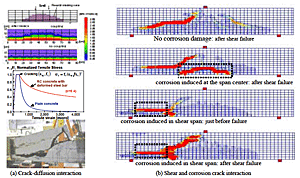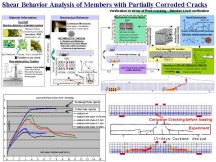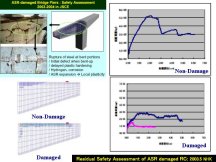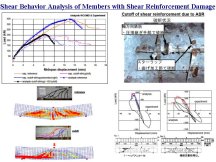Response Evaluation of Members with Steel Corrosion and Structural Performance Assessment
-Corrosion and Alkali-Silica-Reaction-
Created in Japanese on 3rd July 2004.
Translated into English on 10th August 2004.
Research and development is furthered that structural analysis should be also extended to the existing structures with damage so that it can be applied as described at "Estimation of Damaged Structure" etc. By taking advantage of the merit of the plate model which can take loading paths and multi-directional cracking up to four directions into consideration faithfully, development of evaluation method with generality and future expansibility has being strived. The developers can obtain good fruits of research work with some cases lately and attain upgrade of the analytical method.
While reinforcing bar inside concrete is in the condition of being hard to corrode since concrete is usually strong alkalinity, it may corrode in some cases when oxygen, carbon dioxide, and chloride ion etc. permeate gradually between service periods. If appropreate treatment is not performed at this time, crack may propagate into concrete around reinforcement by cubical expansion due to corrosion, or the cross sectional area of reinforcement which can resist to tension force may decrease. Moreover, it is known that steel corrosion and the accompanying cracks occur partially according to very local conditions of humidity, wind, rain water and so on.
Investigations evaluating by COM3 and WCOMD load-resistant mechanism of members in which such the partial corrosion and the accompanying cracks due to cubic expansion of steel or insufficient anchorage generate has been advanced, by also utilizing the knowledge on DuCOM and cooperating these mutually. The accuracy of WCOMD is verified through comparison examination with loading experiments, and it is recognized that the simulation can approximately evaluate the situation that failure mode or shear capacity changes according to damage location1)〜3) etc..


Pictures expanded when clicked.
Cases that the bending anchorage part of shear reinforcement ruptures by expansion due to alkali-silica-reaction are recently reported in Japan. COM3 and WCOMD were promptly applied to the evaluation of residual capacity and performance of real structures which became anchorage defectiveness, and it were also introduced in press, such as NHK, in April 2003. The following figures are examples of the simulation of the experiment conducted in order to verify the accuracy of WCOMD to shear behavior of the member with damage on shear reinforcement3),4). It becomes possible to reproduce faithfully variation of failure mode and shear capacity.


Pictures expanded when clicked.
By the process of research and development as shown here, the measure for the life-cycle assessment of infrastructure establishment utilizing simulation technology is becoming actual still more5),6).
"Journal of Advanced Concrete Technology" in References below is English Academic Journal published by Japan Concrete Institute.
References
| 1) |
Kukrit TOONGOENTHONG and Koichi MAEKAWA : Shear Capacity of Damaged RC Beam with Partial Longitudinal Cracks in Space, Proc. of JCI, Vol.26, JCI, July 2004. |
|
| 2) |
Koichi MAEKAWA, Tetsuya ISHIDA and Toshiharu KISHI : Multi-scale Modeling of Concrete Performance -Integrated Material and Structural Mechanics, Journal of Advanced Concrete Technology, Vol. 1, No. 2, pp.91-126, 2003. |
|
| 3) |
Kukrit TOONGOENTHONG and Koichi MAEKAWA : Unified FEM Computaional Approach for Material Expansion inside RC due to Reinforcement Corrosion and ASR, CONSEC '04, June 2004. |
|
| 4) |
Koichi MAEKAWA, Hikaru NAKAMURA, Yasuhiko SATO and Kukrit TOONGOENTHONG : The Influence of Insufficient Anchorage of Web Reinforcement to Shear Capacity of RC Beams, Proc. of JCI, Vol.26, JCI, July 2004. (in Japanese) |
|
| 5) |
Kukrit TOONGOENTHONG and Koichi MAEKAWA : Multi-Mechanical Approach to Structural Performance Assessment of Corroded RC Members in Shear, Journal of Advanced Concrete Technology, Vol. 3, No. 1, pp.107-122, 2005. |
|
| 6) |
Kukrit TOONGOENTHONG and Koichi MAEKAWA : Computational Performance Assessment of Damaged RC Members with Fractured Stirrups, Journal of Advanced Concrete Technology, Vol. 3, No. 1, pp.123-136, 2005. |
Close
|